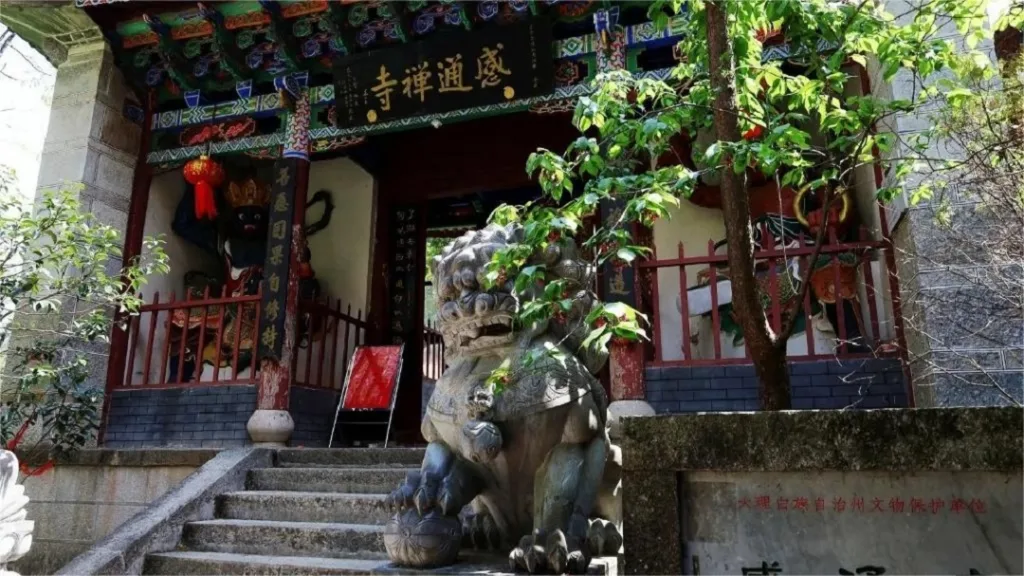Wuwei Temple (无为寺), built in the ninth year of the Tang Dynasty’s Yuanzhen era (793 AD), holds a profound historical and cultural significance in Dali. Its establishment traces back to the arrival of the revered Indian monk Zandou Jueduo in the Nanzhao Kingdom, present-day Yunnan Province. Nanzhao King Geluofeng, deeply influenced by Zandou Jueduo’s teachings, embraced Buddhism under his guidance, becoming one of his disciples. In gratitude for his master’s teachings, Geluofeng proposed the construction of a serene temple for Zandou Jueduo, selecting the site beneath the Lanfeng Peak where the venerable monk once meditated.
Upon completion, a dilemma arose in naming the temple. It was resolved when the Bodhisattva Avalokitesvara descended from the clouds, resonating like a mighty bell, and proclaimed in verse: “With action yet without action, with shore yet without shore, dwelling in the Dragon Abyss, the mind reaches the other shore.” Henceforth, the temple was named “Wuwei,” meaning “actionless.”
Table of Contents
- Basic Information
- Location and Transportation
- Highlights of Wuwei Temple
- Vlog about Wuwei Temple
- Other Attractions on Cangshan Mountain
Basic Information
| Estimated Length of Tour | 1 – 2 hours |
| Ticket Price | Free |
| Opening Hours | 6.00 – 18.00 |
Location and Transportation
Wuwei Temple is located in Dali City, Dali Bai Autonomous Prefecture, Yunnan Province, China. Situated approximately 460 meters west of the Yinqiao Mining Line and 5 kilometers from the ancient city of Dali, it is easily accessible from the city center. Visitors can take bus C7 from Dali Ancient City to Wuwei Temple Station and walk the remaining distance. Alternatively, taxis are readily available for direct transportation to the temple.
Highlights of Wuwei Temple
Unique Architectural Style

Nestled amidst the verdant slopes of the Lanfeng Peak in the Cangshan Mountains, Wuwei Temple boasts a picturesque setting, enveloped by towering peaks and lush foliage, resembling a natural landscape painting. The architectural style of Wuwei Temple is distinctive, blending traditional Han Chinese elements of dougong brackets and upturned eaves with features reminiscent of the Bai ethnic minority dwellings. This fusion exemplifies the cultural exchange and integration prevalent in the Dali region. The main structures of the temple include the Mahavira Hall, which enshrines a solemn statue of Shakyamuni Buddha, radiating a sense of reverence. Vivid frescoes adorn the walls, depicting Buddhist stories and figures with vibrant colors and fluid lines. When sunlight filters through the clouds, casting golden rays upon the ancient edifice, it creates a mesmerizing contrast with the deep gray tiles, accentuating its timeless charm and mystique.
Historic Significance

During the heyday of the Dali Kingdom, Wuwei Temple served as a royal sanctuary, where kings sought spiritual guidance, royal heirs undertook monastic vows, and members of the royal family engaged in scholarly pursuits and artistic endeavors. Ten of the twenty-two emperors of the Dali Kingdom renounced their throne to become monks at this sacred site. Additionally, fifteen royal descendants from the Duan and Shi families took ordination at Wuwei Temple, a practice rare in the secular world. Throughout history, Wuwei Temple’s eminent status and influence attracted numerous dignitaries, scholars, and eminent monks, who came to pay homage and engage in spiritual practices.
Wuwei Temple preserves a wealth of precious relics and historical artifacts, including stone steles and scripture pillars dating back to the Tang and Song Dynasties. These artifacts provide invaluable material evidence for the study of Dali’s history and culture, shedding light on its rich heritage and profound spiritual legacy.






